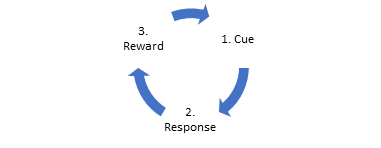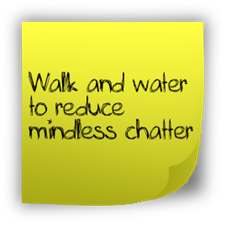In Part 1, we discussed how to identify our timewasting kryptonite(s) using time logs. I know I suggested starting small. The longer you keep time logs, though, you’ll get a truer and more realistic picture of how you spend your time. Using just a one-week sample may not be truly indicative of your patterns. Also, it’s hard for anyone to find a “typical” week because let’s admit it, no two weeks, for that matter, no two days are alike.
All that said, keeping and analyzing time logs, even for a short duration, can help us identify at least some immediate timewasting culprits. In my opinion, that’s a good enough trade-off. We’re simply trying make our own lives more meaningful, not trying to publish in a scientific journal.
So, without letting perfect be the enemy of good, let’s get started. And hey, once you have these habits mastered, you can always repeat the exercise later to find other timewasting lurkers out there!
Now, settle down and pull up your ‘report’.
Is there an ‘Aha’ / ‘Eureka’ moment here? Like – dang – I can’t believe I spend 2 hours a day checking email on my phone (I call this one!). Or scrolling through clickbait headlines. Or cat videos. Or celebrity before and after pics.
Or are you simply seeing hard evidence validating what you knew all along?
This analysis of how you spend time, in itself can be therapeutic. You will likely encounter resistance as you go through this process. The goal here is to get to acceptance stage of this discovery. No blame. No shame. I notice a lot of parallels in this analysis to the 5 stages of grief.
- Denial. My family points out that I obsessively check my email too many times and I’ve always vehemently denied it. Now I have hard, irrefutable evidence. Oops!
- Anger. ‘What the ‘xxxx (insert your favorite expletive here)’? ‘This is so not me’. Must have had a bad day.
- Blame. We’ll replace the ‘bargaining’ that’s part of the grief cycle with ‘blame’ instead. ‘I would certainly not have had to check my email repeatedly if only (*villain name*) had actually sent that one email as promised’.
- Sadness. Feeling sorry for yourself.
- Acceptance. ‘Okay, at least I know now. What next’?
Ultimately, once we get to acceptance, we are ready to remediate. That’s where we begin our journey today.
Our goal is to find a way to pivot from these undesirable activities. If you have more than one activity (or an entire list) that you find objectionable, start with the one that consumes most of your leisure time. More bang for your buck here. Plus, always a good idea to not bite more than you can chew.
To make this easier to understand, I’m going to use an example here from my own time log. I discovered that I spent a whopping 160-180 minutes a day on handling communications – emails, texts and WhatsApp messages. Checking, rechecking, double-checking, refreshing, responding, deleting, organizing etc. etc. Endlessly. A lot of effort traded in for very little accomplishment.
Now, you may ask, how on earth can checking email be considered a pleasurable activity? This is tied to a concept called variable rewards a that it the act of checking for messages releases dopamine (pleasure hormone), so the brain favors and craves for it.
The first step to salvation here is root-cause analysis (sorry to sound like a corporate hack). I went back to the activity log to see what action occurred prior to my checking email on my phone. Tada! I found a pattern. I was in the midst of one of these types of tasks:
- A difficult task requiring focus. Working on taxes, creative writing project etc.
- A task I didn’t really want to but had to do. Writing a work deliverable. (Yes, it indeed is as boring as it sounds!)
- I had just completed something (cooking/laundry) and was looking for a filler / reward.
You’re thinking, ‘Okay Einstein, so what’?! As humans, we are evolutionarily wired to:
- Avoid activities that produce discomfort/pain
- Replace discomfort/pain with comfort/ pleasure
So, if an activity causes you to step beyond your comfort zone, your self-soothing brain is seeking to make up for it by searching for ways to make it all be better. Pronto. In my example, activities a and b are both outside comfort zone, so I was keen to get back to familiar territory, aka checking email while with activity c I was simply avoiding starting something difficult.
Have you tried sitting with pain/discomfort? I’ve been on meditation courses where I was taught to simply ‘observe’ the sensation of pain/discomfort and be ‘curious’ about it. Just about the hardest thing I’ve ever done. I, and am sure I can speak for most of us, have spent an entire lifetime perfecting the art of pivoting into comfort at the first sign of discomfort. Nothing wrong with that for the most part. However, for personal growth, it is imperative we step out of this bubble to peek at what’s on the other side.
So how do we move forward? This requires a short lesson on the science of Habits. There are plenty of great books and blogs on this subject. A couple of my highly recommended favorites are referenced in the footnotes here1.
The gist of habit science is that all habits go through a cycle of Cue – Response – Reward.

Cue (1) causes a Response (2) in anticipation of a Reward (3).
In my example here, triggered by discomfort in the midst of a difficult task, seeing my phone is the cue causing me to respond by scrolling through messages hoping for excitement (reward).

In theory, if you take away the reward or the cue the cycle will be weakened or broken and the response will vanish, sooner or later.
I first attempted to make the reward less desirable. As alluded to earlier, it’s not that simple to make digital distractions such as email less enticing. That’s because checking for messages results in the brain receiving what are termed “variable rewards”. Loosely translated, this means, the rewards are not always consistent. Most times you may not find something you like but the possibility always exists that every once in a while, you could win the ‘message lottery’ such as an exciting announcement, a new job offer etc. This randomness and unpredictability in the reward is what makes it all the more alluring and addictive. This is why slot machines are so popular.
Since it was inherently hard to make the reward less desirable, I decided to tinker around with the other variable, the cue.
When triggered by discomfort such as boredom, why pick up the phone to check email instead of let’s say, walking over to get a glass of water?
The answer is in, what I refer to as ‘the law of least effort’. My phone is always available by my side. As I type my project report at work and encounter resistance in the form of boredom, it is almost automatic for me to pick up the phone and start scrolling. So, seeing the phone is the cue.
Once our brain senses the cue it doesn’t take long for the response (picking up the phone to scroll) to kick in. That’s because these neural pathways have been trained over and over again. An entire industry owes its existence to this phenomenon – hello social media!
Here are some options to eliminate or weaken the cue and also make it difficult to respond to the cue. I’ve highlighted some key, obvious ones below:
- Silence the phone (both audio and visual) by disabling notifications. The device’s distractive power is usually magnitudes worse when there are constant dings, rings and bells emanating from it. Every ding strengthens the cue.
- Physical distancing from the device by leaving it locked in a bag or in another room. The fact that I have to perform a series of steps – taking it out of the bag, powering it on, unlocking etc. buys me time to act.
- Other extreme suggestions I’ve heard range from deleting all email/messaging apps from the phone and only viewing them on a computer. Or not saving email passwords on the phone, requiring you to type in a password every time you want to check email.
I guess desperate situations call for desperate measures. The ingenuity of the human race to dig themselves out of holes they created in the first place, never ceases to amaze me.
If avoiding the cue is almost impossible, then the next best thing to do is to use the cue to transform the response. Every time I have the urge to reach for my phone, I make a deal with myself to walk for a minute or two before I’m allowed to view email. Basically, anything to put some time and distance between the cue and response. This will require some mindfulness. Since that’s hard to come by, I’ve stuck post-it notes on my phone to remind me.

Note: Don’t replace one undesirable habit with another. For instance, walking to get a sweet treat or a snack instead of water in the above situation, will create a different problem. We’re here to solve not create problems.
The examples illustrated above works for all manner of digital distractions. For instance, after you finish watching a TV show, you can choose to remove the batteries from the remote. Having a non-functioning remote should give you pause next time you mindlessly turn on the TV after dinner. The time it takes for you to reinsert the batteries is enough to break the automaticity of the habit.
Similar successes can be achieved for other distractions. The key is to add a deterrent and make the reward less accessible. I had a friend who constantly reached for a sweet treat every time she needed a break. She was not willing to completely give up the habit, but she came to a compromise and moved her stash to the basement. She would have to walk though a whole flight of stairs to the other end of her house to find her stash, something she still did, but only when she absolutely wanted to.
So, it’s really that simple in theory to change undesirable time leaks and get your free time back. Time for you to take this knowledge into the world for a spin:
- Identify the trigger and cue for the one habit you want to change
- See if you can make the reward less desirable
- Introduce an irritant between your cue and response
Good luck! Now that you’ll have a lot of free time back, use that to intentionally on timewasting activities you enjoy. Reach out to me and keep me posted. Happy intentional timewasting!
Recommended books on Habits:
- The power of Habit – Charles Duhigg
- Atomic Habits – James Clear


Amazing thoughts
Thank you for taking time to read.
Really enjoyed reading it, now thinking of all the cues, responses and rewards, seems like every little thing nowadays. If nothing else, hopefully this awareness will stay.
Yes, being aware in the moment is what’s it’s all about. Thank you so much, Div for taking time in the midst of everything else. Your support and encouragement mean a lot to me.
Love it.
Thank you Benu.